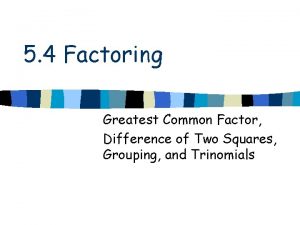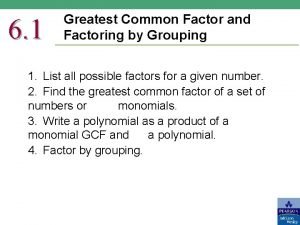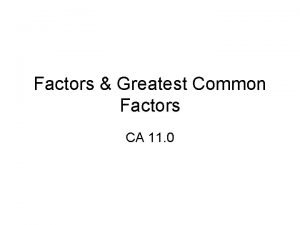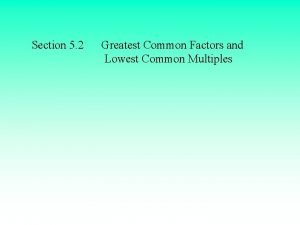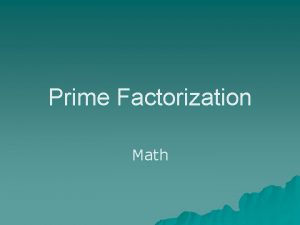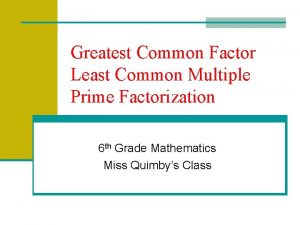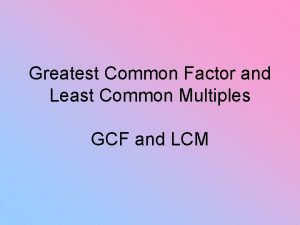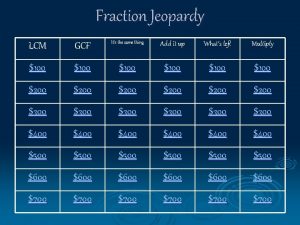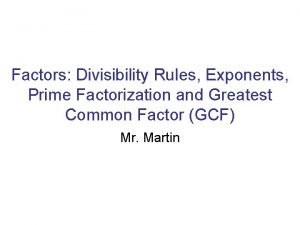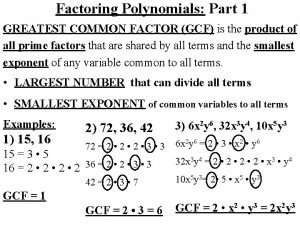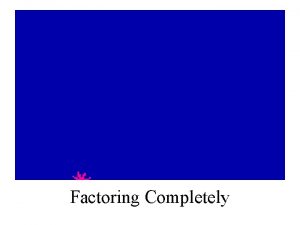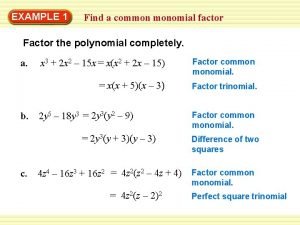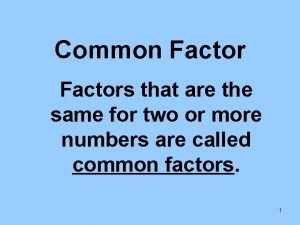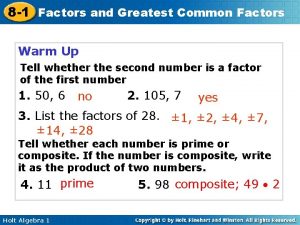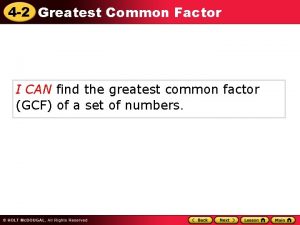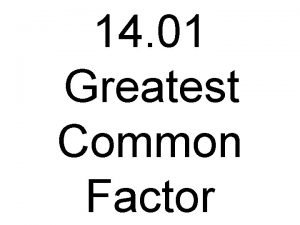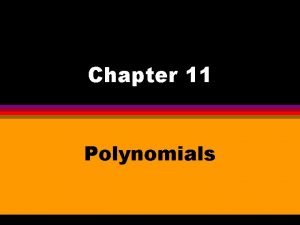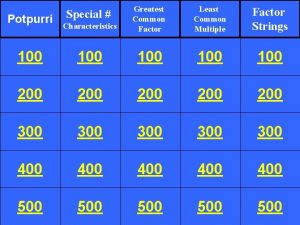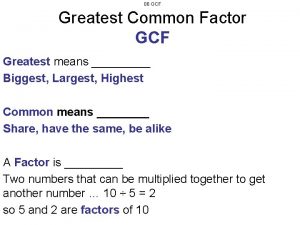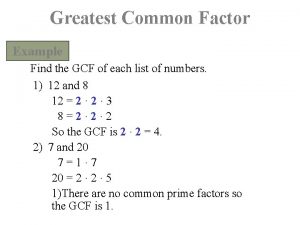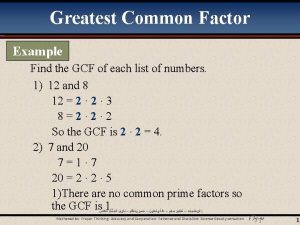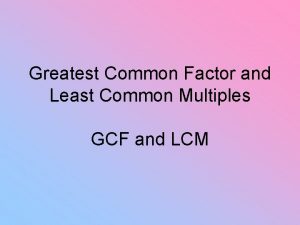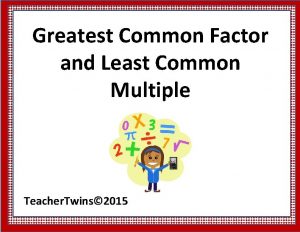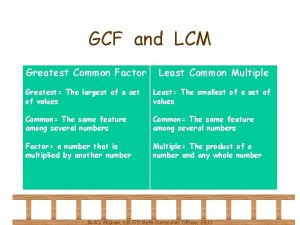Do Now Find the greatest common factor 72





































- Slides: 37

Do Now: Find the greatest common factor: 72 and 96 Simplify

Greatest Common Factor (GCF) � The Greatest Common Factor (GCF) of two or more numbers is the largest number that can divide into all of the numbers.

GCF � To find the GCF, start by writing out the prime factorization. What factors do the numbers have in common? Circle these then multiply the common factors to get your answer. � Example: find the GCF of 42 and 60.

Find the GCF of each of the following: 1. 144, 36 2. 144 x 2 y 4, 36 x 5 y 3 Factor out the GCF: 3. 144 x 2 y 4 + 36 x 5 y 3 4. 14 x 2 – 7 x + 21

Examples 2. Find the GCF of 12 a 3 b 4 and 3 a 5 b. 3. Find the GCF of 7 x 2 y 2 and 10 xy 3.

Remember this warm up problem? � Multiply: � We 2 x(5 x + 3) can work backwards. What if I gave you the answer 10 x 2 + 6 x, and asked you for the original problem?

We can also “undistribute” our warm up problem � Find the GCF then use the distributive property to factor out the GCF. � What are we really doing? Take out the GCF and then write your “leftovers” on the inside. � Example 13: 10 x 2 + 6 x

We can also find the GCF of a polynomial… � Factor out the GCF of all of the terms. � Example 9: 3 x 3 y – 9 x 2 y 2 � Example 10: 12 x 3 – 8 x 2 + 16 x

Factoring by Grouping � You can try to factor by grouping when your polynomial has four terms.

2. GCF first! Then separate your terms in pairs using 3. Find the 1. 4. Always look for a parenthesis. GCF for each binomial. Your answer will be (GCF’s)(leftovers). ***Your leftovers must match***

Example #1 Always look for a GCF first! Then group your terms in pairs using parenthesis. Find the GCF for each binomial. Your answer will be (GCF’s)(leftovers). Your leftovers must match! Factor: 12 x 3 + 3 x 2 + 20 x + 5

Factor: 3 12 x + 2 3 x + 20 x + 5

Check Answer: (3 x 2 + 5) (4 x + 1) Box or FOIL Method 12 x 3 + 3 x 2 + 20 x + 5

Factor: 5 a 2 x – 4 a 2 c + 15 x 2 – 12 xc

Check Answer: (a 2 + 3) (5 x – 4 c) Box or FOIL Method 5 a 2 x – 4 a 2 c + 15 x 2 – 12 xc

Factor: 4 v 3 – 12 v 2 – 5 v + 15

Check Answer: (4 v 2 – 5) (v – 3) Box or FOIL Method 4 v 3 – 12 v 2 – 5 v + 15

Factor: 21 xy – 12 b 2 + 14 xb – 18 by

Check Answer: Can you factor? What happened?

You Try: 8 x 2 + 8 xy + 2 y 2 + 2 xy

Check Answer: (8 x + 2 y) (x + y) Box or FOIL Method 8 x 2 + 8 xy + 2 y 2 + 2 xy

You Try: 21 k 3 – 84 k 2 + 15 k – 60

Check Answer: (21 k 2 + 15) (k – 4) Box or FOIL Method 21 k 3 – 84 k 2 + 15 k – 60

Error Analysis Factor 20 p 3 + 40 p 2 + 15 p + 30. (20 p 3 + 40 p 2) + (15 p + 30) 20 p 2(p + 2) + 15(p + 2)(20 p 2)

Factoring Standard Form: ax 2 + bx + c

How to factor… �We have to find a number that multiplies to the “c” term whose factors add to the “b” term (x +7)(x + 3) = x 2 + 10 x + 21 7 • 3 = 21 7 + 3 = 10

Let’s do some examples… o What d ve they ha to ly multip to? x 2 + 5 x + 6 What do they have to add to?

o What d ve they ha to ly multip to? x 2 + 7 x + 6 What do they have to add to?

x 2 + 14 x + 45 d 2 – 6 d – 27

x 2 – 3 x - 28 x 2 – 16 x + 48

x 2 + 12 x + 32 x 2 - 25

Do Now:

Factoring when a ≠ 1

Recall Standard form ax 2 + bx + c All the examples we have been doing with factoring, a = 1. However this is not always the case. When there is a coefficient on the x 2 term, and a GCF cannot be taken out, we have to factor a bit differently.

Wrong/Right � Steps: 1. Pull out a GCF of the whole trinomial 2. Write the trinomial as two binomials with the “a” term as the coefficient 3. Multiply the “a” term and the “c” term. 4. See what multiples to “ac” and adds to the “b” term 5. Write in the binomials � This is WRONG 6. We have to make it right by reducing by the GCF, if no GCF, we rewrite � This is the RIGHT answer!

3 y 2 + 14 y + 8 ac = 3*8 = 24 *24 +14 1*24 25 2*12 14 3*8 11 4*6 10 W - ( 3 y + 2 ) ( 3 y + 12 ) R - ( 3 y + 2 ) (y + 4 )

2 y 2 – 7 y - 15
 Factors 0f 18
Factors 0f 18 Factoring greatest common factor
Factoring greatest common factor Factor gcf
Factor gcf Factors of 60 and 48
Factors of 60 and 48 Greatest common factor of 60
Greatest common factor of 60 Gcf of 24 and 36
Gcf of 24 and 36 Gcf of 12 and 6
Gcf of 12 and 6 Highest common factor
Highest common factor Dactors of 75
Dactors of 75 Factors of 8 and 3
Factors of 8 and 3 Greatest common factor of 56 and 35
Greatest common factor of 56 and 35 Factors of 56 that are perfect squares
Factors of 56 that are perfect squares Common factors of 72 and 120
Common factors of 72 and 120 Factors o 72
Factors o 72 Lesson 1 factoring using the greatest common factor
Lesson 1 factoring using the greatest common factor What is the greatest common factor of 42 and 84
What is the greatest common factor of 42 and 84 32 and 48 gcf
32 and 48 gcf Highest common factor of 60 and 96
Highest common factor of 60 and 96 Greatest common factor of 7 and 9
Greatest common factor of 7 and 9 18 and 15 gcf
18 and 15 gcf Gcf of 42 and 84
Gcf of 42 and 84 Factors of 36 and 24
Factors of 36 and 24 All factors of 60
All factors of 60 Greatest common factor rules
Greatest common factor rules Factoring 1 factoring out the gcf
Factoring 1 factoring out the gcf Factoring by gcf
Factoring by gcf Factoring completely
Factoring completely Common monomial factor example
Common monomial factor example Factors of 18
Factors of 18 Greatest common factor of 60
Greatest common factor of 60 Gcf of 8 and 28
Gcf of 8 and 28 What are all the factors of 63
What are all the factors of 63 The largest factor of a number is
The largest factor of a number is Greatest prime factor of 77
Greatest prime factor of 77 Common multiples of 3 5 and 7
Common multiples of 3 5 and 7 Lesson 1 factoring using the greatest common factor
Lesson 1 factoring using the greatest common factor Greatest common monomial factor of 5a3+a3b
Greatest common monomial factor of 5a3+a3b Greatest common factor prime factorization
Greatest common factor prime factorization

